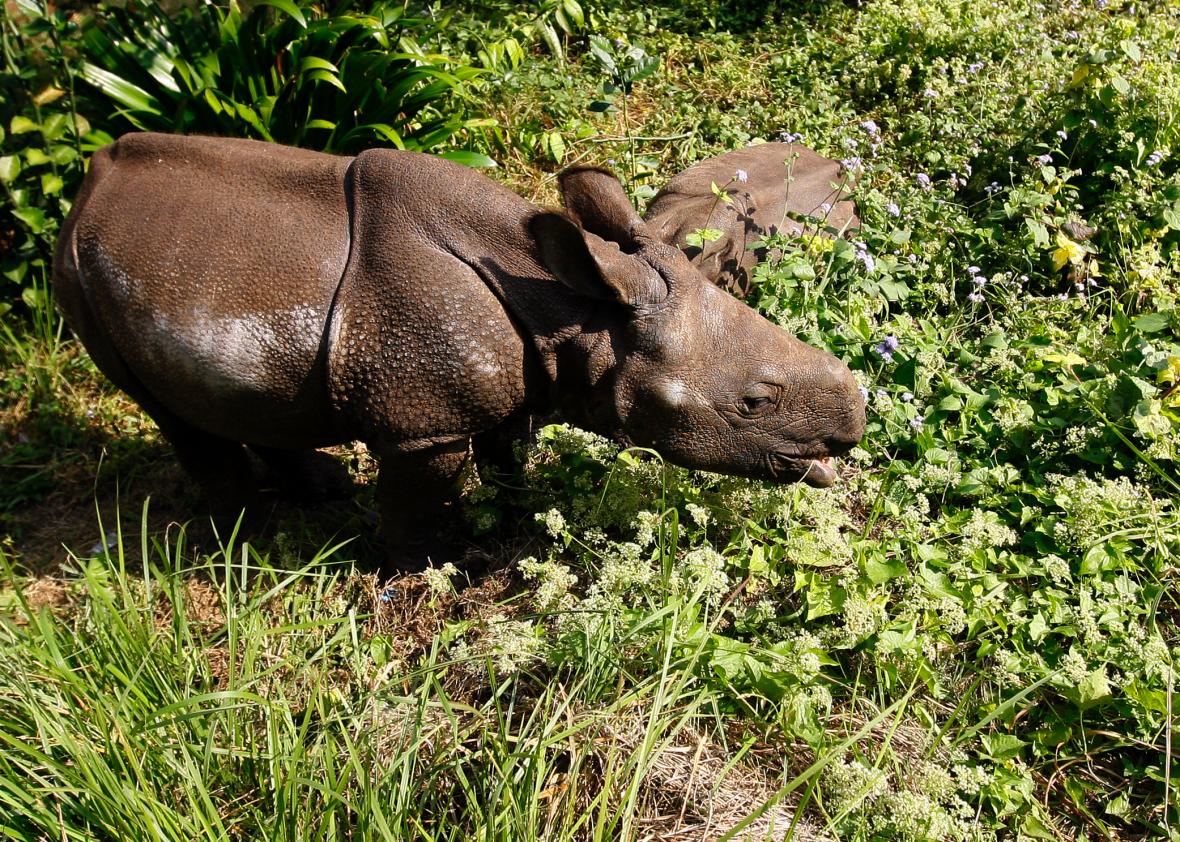
Prakash Mathema/AFP/GettyImages
Can drones help make conservation groups more effective at monitoring and protecting wildlife and natural resources? In many ways, they already are. As Nancy Averett wrote in the July-August 2014 issue of Audubon, drones “don’t offer just a safer way for scientists to observe their subjects; they’re often less costly, more efficient, and more precise than traditional approaches.” Conservation organizations have experimented with using drones for many tasks: counting and monitoring flora and fauna; fighting deforestation; deterring poachers and other outdoorsy villains. “For underequipped and underresourced park rangers, drones can be enormously valuable not just for detecting illegal activities, but far more for protecting the ecoguards from encounters with very violent illegal hunters,” David Wilkie of the Wildlife Conservation Society told me. Sounds like a no-brainer.
A new academic paper on the social implications of drone-aided conservation efforts complicates this picture. In an article for the November 2015 issue of the academic journal Ambio, Cambridge geographer Chris Sandbrook suggests that while drones can be very useful for conservation purposes, they also have the potential to alienate human stakeholders and in turn make conservation even more difficult. Conservation is rarely practiced in blank space: Locals often also lay claim to the land and wildlife being monitored and studied, and they don’t always approve of the conservationists’ methods. Sandbrook fears that unexplained drone flights could foster an adversarial relationship between locals and conservation groups.
“The last twenty or so years of conservation practice have been characterised by efforts to move away from the so-called ‘fortress conservation’ or ‘fences and fines’ strategies based on exclusion and negative incentives towards more inclusive approaches that involve local people in conservation and share benefits with them,” writes Sandbrook. “Drones might undermine this conservation paradigm by creating the impression, intended or otherwise, of a return to a militarised fortress conservation approach. It seems plausible, and even probable, that such perceptions of drones would make other conservation activities more difficult.”
Before addressing Sandbrook’s point, it’s important to acknowledge that drones make lots of conservation activities much, much easier. Launching a drone to survey a parcel of land and counting the trees and zebras (or whatever) contained therein is much simpler and less expensive than launching a manned aircraft or ground patrol to do the same thing. It’s safer, too: If a drone crashes while observing wildlife in the field, the drone is destroyed; if a plane crashes while doing the same thing, all the people aboard will probably die.
Sandbrook notes that “the most commonly identified direct application of drones is for law enforcement and the monitoring of illegal activities, particularly in the context of illegal hunting of wildlife.” Thomas Snitch of the University of Maryland’s Institute for Advanced Computer Studies has written for Slate about his team’s successes with using drones to fight poaching in Africa. “I have been preaching that [unmanned aerial vehicles] are NOT a silver bullet but are simply a tool to increase the effectiveness of a variety of anti-poaching efforts,” he told me in a recent email. “Before we send out a patrol at night, we fly a UAV out in front of them to clear their path. With [infrared] cameras on the drone, we remove the possibility of a hidden ambush. This saves the lives of rangers.” Not only can drones provide a safer, more nimble means of spotting poachers at work, but the prospect of being watched at any time by tiny aerial cameras that often cannot be seen from the ground is the sort of thing that might theoretically discourage poachers from heading to work in the first place.
But Sandbrook argues that poachers aren’t the only people who might be frightened by the drones. “If people on the ground do not understand, or refuse to believe, why drones are being introduced, they may generate conspiracy theories, suspicions and fantasies, particularly when they are used in remote areas in developing countries which have little prior exposure to electronic devices,” wrote Sandbrook.
He speculates that even those locals who understand why drones are being used might still resent them or resist their deployment. Sandbrook notes the “long history of conflict and disputes” between conservation groups and locals who believe that the conservators’ actions and intentions “are contrary to local interests.” In the absence of clear communication about how the drones will be used, how the gathered data will be stored, and to whom that data will be made accessible, drone-aided surveying and monitoring might dissuade the suspicious from cooperating with conservation efforts.
“That’s a reasonable assumption, that if strange things are happening, that people might be confused,” David Wilkie told me. “Especially if communities have formal, tenurial rights over the land, then you’d expect that the police would seek permission for flying drones over this land.” But Wilkie posits that the real problem isn’t drone-borne alienation so much as police and conservancies that are unwilling to communicate or work with locals. “If the community doesn’t trust the police, and the police likewise think the community are brigands or always breaking the law, then you’ve got a tension between the two groups that makes it almost impossible to have a just and fair application of the law,” he said. Bad policing and bad policy will engender fear and alienation regardless of whether groups are using drones, helicopters, four-by-fours, or old-timey bicycles.
Drone-aided conservation is still a new field, and Sandbrook admits that “there is an almost complete lack of field data to confirm or disprove the possible social impacts of drones identified by this paper.” Further study is obviously necessary. But it’s important to realize that conservation is an ongoing process, and sustainable conservation efforts ought to incorporate input from locals who will be impacted by it. “To me, bad policing is bad policing regardless of whether you do it with drones or not,” said Wilkie. “That’s the underlying problem, not the use of drones.”
http://www.slate.com/blogs/future_tense/2016/02/16/chris_sandbrook_argues_that_using_drones_for_conservation_could_backfire.html

